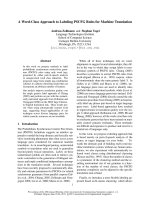Design a surface flow CWs to treat domestic wastewater for an residential area
Bạn đang xem bản rút gọn của tài liệu. Xem và tải ngay bản đầy đủ của tài liệu tại đây (467.99 KB, 10 trang )
Design a surface flow CWs to
treat domestic wastewater for
an residential area
Group 11 :
Đặng Minh Sơn
Nguyễn Quang Văn
Nguyễn Thanh Tùng
Vũ Thị Thu Trang
Table of Contents
................................................................................1
Design a surface flow CWs to treat domestic wastewater for an residential area.......1
I. Introduction....................................................................................................................3
II. Designing.......................................................................................................................5
III.Result............................................................................................................................9
IV. Conclusion ...................................................................................................................9
IV. References..................................................................................................................10
I. Introduction
Wastewater treatment by wetland technology (also known as wet soil leach, leach
plant, bio leach ...) has been studied and applied long around the world. Research by
wastewater treatment plant wetland vegetation was first made by Seidel (1955) at
the Max Planck Institute in Plon, Germany. Since then, this technology has been
applied and developed in Europe, America, Australia ... in the years from 1970 to 2000.
In our country, the research is done at universities, research institutes in recent years
has given the initial results are very encouraging. At the same time, some of the
practical applications have been implemented for water treatment and industrial
waste in a number of provinces and cities nationwide.
Most domestic wastewater in the residential urban, suburban and rural Vietnam are
not handled properly. Wastewater from toilets only preliminary treatment,
unsatisfactory discharge into the environment has been mixed with waste water from
the kitchen, bathroom, laundry ... cause pollution, the spread of diseases. Thus, in the
present context, where drainage projects and water treatment have not been
everywhere, if so, just stop at the drainage situation and overcome the flooding,
waterlogging, and also a lot of costs for operation and maintenance of the system,
then the study of clean water to households family, or residential areas, with
appropriate technology, simple, cost less to build and operate, while ensuring
environmental sanitation solutions is a reasonable and feasible.
In this our presentation, we will introduce to you, the way using horizontal surface
flow treat domestic waste water of a residential area of 1000 peple
Let make clear what is horizontal surface flow : These systems typically consist of
basins or
channels, with some sort of subsurface barrier to prevent seepage, soil or another
suitable medium to support the emergent vegetation, and water at a relatively
shallow depth flowing through the unit. The shallow water depth, low flow velocity,
and presence of the plant stalks and litter regulate water flow and, especially in long,
narrow channels minimize short circuiting.
II. Designing
A. Domestic wastewater compositions
Domestic wastewater contains BOD, SS, NH4+, Nitrogen, Phosphorus,
Microorganisms….
Compositions
Unit
Amount
1
2
pH
BOD5
mg/l
6.5 - 8.5
250 – 400
3
COD
mg/l
400 – 700
4
TSS
mg/l
300 – 400
5
Total Nitrogen
mg/l
60
6
Total Phosphorus
mg/l
6.86
Table1: Typically polluted concentration and compositions
Wastewater treating is in order to remove contaminants before discharging to the
culverts or recycling
Water quality after treatment must satisfy the National technical regulation on
domestic wastewater–QCVN 14:2008/BTNMT
Table2: Value of maximum parameter allowed used for calculating in domestic
wastewater
Parameter
Unit
Concentration C
A
B
1
pH
-
5–9
5-9
2
BOD5 (20oC)
mg/l
30
50
3
Total suspended solid (TSS) mg/l
50
100
4
Total dissolved solid (TDS)
mg/l
500
1000
5
Sulfur (H2S)
mg/l
1.0
4.0
6
Ammonium
mg/l
5
10
7
Nitrate (NO3-)
mg/l
30
50
8
Lipid
mg/l
10
20
9
Surface active agents
mg/l
5
10
10
Phosphate (PO43-)
mg/l
6
10
11
Total Coliforms
MPN/100 ml 3000
5000
A: concentration of maximum parameter allowed in DWW when discharging into the
sources using for activities supply.
B: concentration of maximum parameter allowed in DWW when discharging into the
sources NOT using for activities supply.
Usually, wastewater after treatment is discharged to the rivers then could be recycled
column A will be used for calculating surface flow model.
Compare between inflow water (not yet treated) and allowance water according to
Regulation (will be outflow water):
Compositions Unit
Amount
Amount
(influence) Co (effluence) Ce
1
2
pH
BOD5
mg/l
6.5 - 8.5
250 – 400
5–9
30
3
COD
mg/l
400 – 700
-
8 – 13 times
higher
-
4
TSS
mg/l
300 – 400
50
6 – 8 times higher
5
Total Nitrogen mg/l
60
30
-
6
Total
Phosphorus
6.86
6
-
mg/l
Since TSS can be easily removed by filtration or deposition then we consider BOD the
main parameter for CW SF calculation.
B. CW calculation
Surface calculation
In FWS wetlands, removal of the soluble BOD5 is due to microbial growth attached to
plant roots, stems, and leaf litter that has fallen into the water. Because algae are
typically not present if plant coverage is complete, the major sources of oxygen for
these reactions are reaeration at the water surface and plant translocation of oxygen
from the leaves to the rhizosphere.
Specific criteria presented below are suitable for low to moderate organic loadings.
The organic loading should be distributed over a significant portion of the area and
not applied at a single point. The design water depth should be 600 mm (24 in) (1) or
less to ensure adequate oxygen distribution, and partial effluent recirculation might
be considered in the summer months to overcome ET losses and maintain design flow
rates and oxygen levels.
BOD5 Removal in FWS Wetlands:
C e
= A e
C o
− 0 . 7 K T ( A v )1 .7 5 A s d n
Q
Where,
A = fraction of BOD5 not removed as settleable solids near headworks of the system
(as decimal fraction)
Av = specific surface area for microbial activity, m 2/m3
As = wetland treatment area, m2
d = design depth of system, m
n = porosity of system (as a decimal fraction)
Q = average hydraulic loading on the system, m3/day
K T = temperature-dependent rate constant KT (in day-1) at water temperature T (oC)
A sample calculation for the above coefficients equation yields the following results:
• A = 0.52
• K20 = 0.0057 day-1
• Av = 15.7 m2/m3
• d = 0.6m (recommended)
• n = Vv/V = 0.75
(Vv & V: volume of voids and total volume)
Q = average hydraulic loading on the system, m3/day:
Q = 1,000people x 150L/person/day x 80% =120,000L/day =120m 3 /day
KT = K20 x (1.1)T-20
= 0.0057 day-1 x (1.1)25-20
= 9.2 x 10-3
Average ToC of water is 25oC
K20 is rate constant at 20oC
Our purpose is to find CW surface area As.
Substitution into the formula:
50
= 0 .5 2 e
C o
− 0 . 7 × 9 . 2 ×1 0
−3
×1 5 . 7 1 . 7 5 × A s × 0 . 6 × 0 . 7 5
1 2 0
As ranges from 320.67 m2 to 478.36m2
Assume, length : width = 3 : 1
The length is about 32m ~ 38m
The width is about 10m ~ 13m
Plant and soil
In selecting a site for a free water surface wetland the underlying soil permeability
must be considered.…..
Sandy soils are too permeable to support wetland vegetation unless there is a
restrictive layer in the soil profile that would result in a perched high ground water
table.Highly permeable soils can be used for small wastewater flows by forming
narrow trenches and lining the trench walls and bottom with clay or anartificial liner.
In heavy clay soils, additions of peatmoss or top soil will improve soil permeability and
accelerate initial plant growth
• Soil Permeability for Free Water Surface Systems
• The most desirable soil permeability is 10-6 to 10-7m/s (0.14-0.014 in/hr). Sandy
clays and silty clay loams can be suitable when compacted.
Plant: Canna Hybrid: Strong growth at contaminated wetlands good for NH 4+, NO3-,
PO43- removal
III.Result
Assume, length : width = 3 : 1
The length is about 32m ~ 38m
The width is about 10m ~ 13m
IV. Conclusion
- In terms of social topics will contribute to improving the health of communities
through clean water and create a good view from the technology underground leach
plant.
- In terms of economic and biodiversity: This type of model wastewater by biological
treatment principle does not need to use energy saving will be very effective and
economical when applied in practice than other methods. In addition, the leach plant
can be used as feed for livestock. Treated water can circulate to bathe using pigs, barn
wash or irrigate crops are good.
- In terms of biodiversity conservation: Thread has created a good view and contribute
to increased biodiversity in areas with abundant types of crops in the leach.
IV. References
Basheer, F. (2008). Constructed Wetland System for Wastewater Treatment. India:
Aligarh Muslim University.
EPA. (1988). Constructed Wetlands and Aquatic Plant Systems for Municipal
Wastewater Treatment.
MalaysiaOffice. (2003). The use of constructed wetlands for wastewater treatment.
Selangor, Malaysia: Wetlands International - Malaysia Office.
National technical regulation on domestic wastewater QCVN 14 : 2008/BTNMT









